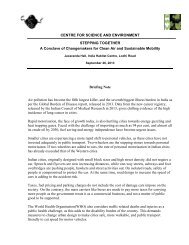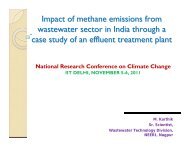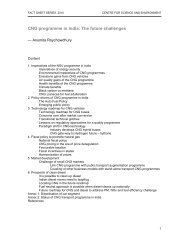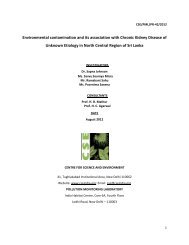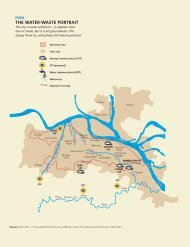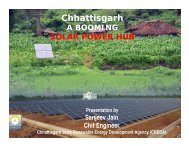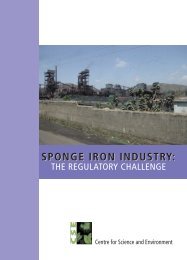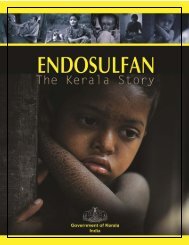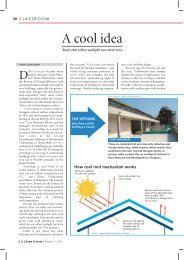Download full report (PDF) - Centre for Science and Environment
Download full report (PDF) - Centre for Science and Environment
Download full report (PDF) - Centre for Science and Environment
Create successful ePaper yourself
Turn your PDF publications into a flip-book with our unique Google optimized e-Paper software.
Decentralised<br />
Wastewater Treatment<br />
A Way to Manage Septage in Shimla<br />
CENTRE FOR SCIENCE AND ENVIRONMENT<br />
New Delhi
We are grateful to the Ministry of Urban Development, Government of India <strong>for</strong> their support to CSE as a<br />
<strong>Centre</strong> of Excellence <strong>for</strong> Sustainable Water Management.<br />
Prepared by<br />
Water Management Team<br />
March 2010<br />
Cover photo shows a DEWATS comprising of baffled reactor, rootzone treatment <strong>and</strong> polishing pond<br />
<strong>Centre</strong> <strong>for</strong> <strong>Science</strong> <strong>and</strong> <strong>Environment</strong><br />
41, Tughlakabad Institutional Area, New Delhi-110062<br />
Phones: 91-11-29955124, 2995125<br />
Fax: 91-11-29955879<br />
Email: cse@cseindia.org<br />
Web: www.cseindia.org
Contents<br />
Abbreviations 4<br />
Executive summary 5<br />
1. Water profile of Shimla city 7<br />
1.1 The city of Shimla 7<br />
1.2 Water profile of Shimla 7<br />
2. Decentralised sewage management options in non-sewered zones of SMC 12<br />
2.1 Why decentralised wastewater treatment systems? 12<br />
2.2 Why decentralised wastewater treatment systems <strong>for</strong> Shimla city? 12<br />
2.3 What are decentralised wastewater treatment systems? 13<br />
2.4. Wastewater treatment - Centralised vs. Decentralised approaches 18<br />
2.5 Possible options <strong>for</strong> unsewered areas 18<br />
2.6 Cost comparison 20<br />
3. CSE’s proposal <strong>for</strong> construction of pilot decentralised treatment<br />
projects in different non-sewered zones 22<br />
3.1 Police Ground, Bharari 22<br />
3.2 Nirmal Awas Residential Apartments 23<br />
3.3 Forest Colony 24<br />
3.4 Himachal Pradesh State Museum 24<br />
4. Conclusion 26<br />
References 27<br />
Annexure 28
Abbreviations<br />
BOD Biological Oxidation Dem<strong>and</strong><br />
COD Chemical Oxidation Dem<strong>and</strong><br />
CSE <strong>Centre</strong> <strong>for</strong> <strong>Science</strong> <strong>and</strong> <strong>Environment</strong><br />
DEWATS Decentralized Waste Water Treatment System<br />
DPR Detailed Project Report<br />
EM Effective Micro-organisms<br />
HGF Horizontal Gravel Filter<br />
JNNURM Jawaharlal Nehru National Urban Renewal Mission<br />
LPCD Liters Per Capita per Day<br />
MC Municipal Corporation<br />
MLD Million Litres per Day<br />
MoUD Ministry of Urban Development<br />
O & M Operation <strong>and</strong> Maintenance<br />
SBT Soil Biotechnology<br />
SMC Shimla Municipal Corporation<br />
SPA Shimla Planning Area<br />
STP Sewage Treatment Plant<br />
TSS Total Suspended Solids<br />
UASB Up-flow Anaerobic Sludge Reactor<br />
WWTP Waste Water Treatment Plants
Executive Summary<br />
1. This is a proposal from the <strong>Centre</strong> <strong>for</strong> <strong>Science</strong> <strong>and</strong> <strong>Environment</strong> (CSE) <strong>for</strong> the implementation of<br />
decentralised wastewater technologies in the municipal zones of Shimla where currently centralised sewage<br />
treatment systems do not exist.<br />
2. CSE has been recognized by the Ministry of Urban Development as a <strong>Centre</strong> of Excellence in the area of<br />
water management. As part of its activities, the Ministry has approved a proposal <strong>for</strong> CSE to take up the city<br />
of Shimla as a pilot case to implement decentralised wastewater treatment technologies.<br />
3. The Municipal Corporation(MC) of Shimla is currently one of the 63 JNNURM cities <strong>and</strong> is in the process of<br />
implementing re<strong>for</strong>ms measures under the programme. The Detailed Project Report <strong>for</strong> the rehabilitation<br />
of the existing sewerage network <strong>and</strong> addition of new network <strong>and</strong> sewage treatment plants is in process.<br />
4. The first sewerage system was laid in Shimla in 1880 <strong>for</strong> a population of about 16,000 people leading to 5<br />
disposal points based on septic <strong>and</strong> sedimentation tanks. In 2005, the MC undertook an augmentation of<br />
the sewerage network by laying new lines <strong>and</strong> constructed 6 new sewage treatment plants with an installed<br />
capacity of 35.63 mld at Lalpani, Summer hill, North disposal, Dhalli, Sanjauli-Maliyana <strong>and</strong> Snowdon.<br />
5. However,<br />
● the old sewerage lines were not adequately connected to the new network.<br />
● some areas in North Disposal, Dhalli & Sanjouli-Malyana are situated below the sewer network.<br />
● the old sewer pipes have become unusable in some of the areas as they are leaking or choked <strong>and</strong><br />
need to be rehabilitated.<br />
● There is no piped sewerage system <strong>for</strong> zones of Totu <strong>and</strong> Jutog.<br />
6. The net result is that the new treatment plants receive only 4.8 mld <strong>for</strong> treatment.<br />
7. The key proposals of the DPR <strong>for</strong> implementation under the JNNURM are as follows:<br />
● Rehabilitation of the main sewerage network<br />
● Provision of sewerage network <strong>for</strong> areas of Dhalli, Tutu, New Shimla <strong>and</strong> special areas of Ghanahatti,<br />
Kufri <strong>and</strong> Shoghi<br />
● Provision of missing links to connect the refurbished old sewerage network with new sewerage network.<br />
8. The total estimated capital cost of the entire project is Rs. 164.48 crore. The annual maintenance <strong>and</strong><br />
operational (O & M) cost is estimated to be Rs. 4.56 crore.<br />
5
6<br />
CENTRE FOR SCIENCE AND ENVIRONMENT<br />
9. CSE’s proposal: CSE proposes that in the new areas where there is no centralised sewerage system, it would<br />
be a better option to go in <strong>for</strong> decentralised sewage treatment technologies, <strong>for</strong> the following reasons:<br />
● The sewerage network <strong>and</strong> the treatment plants of the centralised system have very high capital <strong>and</strong><br />
operational costs. As can be seen by the figures provided by the MC, despite the augmentation of the<br />
sewerage network, hardly 10% of the sewage generated is being treated. Decentralised treatment<br />
systems provide a cost-effective alternative, as they reduce the cost of costly conveyance <strong>and</strong> treatment<br />
plants as well as use locally available materials <strong>for</strong> construction.<br />
● A decentralised treatment plant provides treatment facilities close to the areas served <strong>and</strong> is ideally<br />
suited <strong>for</strong> some of the locations in Shimla where the areas to be served are situated below the sewerage<br />
network <strong>and</strong> cannot be served by a gravity drainage network. It will also obviate the need <strong>for</strong> pumping<br />
stations, thus saving on energy costs.<br />
● Decentralised systems offer the opportunity of wastewater recycling <strong>and</strong> reuse thus reducing water<br />
dem<strong>and</strong> substantially.<br />
● As septic tank systems already exist in these areas, the required investment is little more than improving<br />
the existing technology by introducing improved <strong>for</strong>ms of treatment prior to disposal.<br />
● The newly added zones comprise peri-urban areas where there is a good potential to use treated<br />
wastewater <strong>for</strong> agricultural use <strong>and</strong> can thus improve agricultural productivity.<br />
Area/Zone Proposal as per DPR <strong>for</strong> CSE’s recommendations Pilot projects proposed by CSE<br />
2025 dem<strong>and</strong><br />
North Disposal - 6.69 Km of pipeline 3 DEWATS plants of 50 Kld Police ground , Bharari. Existing septic tank<br />
sub-zone – II <strong>and</strong> 1 STP of each (total 150Kld) augmented with horizontal reed-bed system <strong>and</strong><br />
0.3 mld capacity polishing pond at Rs. 7 lakh.<br />
at Rs. 5.00 crore<br />
Dhalli – sub-zone II 9.99 Km of pipeline 4 Rootzone/soil bio<strong>and</strong><br />
1 STP of technology units of 30 Kld<br />
0.2 mld capacity at each (total 120Kld)<br />
Rs. 6.35 crore<br />
Sanjauli Malyana – 19.74 Km of pipeline 4 DEWATS plants of 30<br />
sub-zone II <strong>and</strong> 1 STP of each (total 120Kld)<br />
0.2 mld capacity<br />
at Rs. 10.83 crore<br />
Nirmal Awas Apartments, Existing septic tank to<br />
be augmented with vertical reed-bed system at<br />
Rs. 6 lakh.<br />
Himachal Pradesh State Museum – Existing septic<br />
tank to be augmented with Dewats system at<br />
Rs. 3.5 lakh.<br />
Totu zone 27.21 Km of pipeline 14 DEWATS plants of Forest Colony. Existing septic tank<br />
<strong>and</strong> 1 STP of 100 Kld each system to be augmented with<br />
2.5 mld capacity baffled reactor <strong>and</strong> 2 vertical<br />
at Rs. 22.58 crore reed-bed systems at Rs. 14 lakh.<br />
Jutogh zone 10.59 Km of pipeline 10 DEWATS plants of<br />
<strong>and</strong> 1 STP of 55 Kld each<br />
1.0 mld capacity<br />
at Rs. 22.58 crore<br />
at Rs. 10.15 crore
1. Water profile of Shimla city<br />
1.1 THE CITY OF SHIMLA<br />
Shimla is the capital city of Himachal Pradesh <strong>and</strong> was the summer capital in pre-independence era. It is situated<br />
at an altitude of 2130 m. above mean sea level. In 1985, the Planning Commission delineated areas with average<br />
slope of 30 percent <strong>and</strong> above as hilly. As per the above classification, Shimla town is classified as a hilly town.<br />
It has been a prime tourist destination.<br />
The Government of Himachal Pradesh constituted the Shimla Planning Area (SPA) through notification in<br />
November 1977, which includes the Shimla Municipal Corporation, special areas of Dhalli, New Shimla, <strong>and</strong><br />
Totu <strong>and</strong> special areas of Kufri, Shoghi <strong>and</strong> Ghanahatti. Shimla Planning Area (SPA), the only Class I city in the<br />
Himachal Pradesh, has a population of 0.17 million persons (2001 census), which accounts <strong>for</strong> 24% population<br />
of the Shimla district. The population of SPA recorded a decadal growth rate of 34.63 per cent between 1991<br />
<strong>and</strong> 2001. It is assumed that population of SPA is anticipated to increase at the rate of 35 % during the decades<br />
of 2011 <strong>and</strong> 2021, which is likely to be 0.23 million <strong>and</strong> 0.32 million respectively. Shimla city being the premier<br />
tourist centre of Himachal Pradesh, has a very high floating population in the summer months. With the accent<br />
on promotion of tourism in the coming years, the floating population is likely to increase.<br />
Under the ambitious Jawaharlal Nehru National Urban Renewal Mission (JNNURM) program of the Government<br />
of India, Shimla has been recognized as one of the 63 urban centres eligible <strong>for</strong> fast-track development. Water<br />
supply <strong>and</strong> sewage management have been recognized as the major focus areas (with collective allocation of<br />
more than a fifth of the total funding under the JNNURM scheme) among others such as tourism promotion,<br />
decongestion, environment <strong>and</strong> heritage conservation, housing etc. Despite having three rivers, namely Pabbar,<br />
Yamuna <strong>and</strong> Giri flowing through it, the city depends heavily on spring water sources <strong>for</strong> its drinking water<br />
which is partly responsible <strong>for</strong> the water shortage the city faces during the lean period from February to May<br />
every year.<br />
1.2 WATER PROFILE OF SHIMLA<br />
1.2.1 Water supply<br />
The authorities responsible <strong>for</strong> water supply in Shimla are the Irrigation <strong>and</strong> Public Health (I&PH) department<br />
<strong>and</strong> the Shimla Municipal Corporation (SMC). The I&PH looks after bulk supply <strong>and</strong> treatment of water while<br />
the SMC is concerned with distribution <strong>and</strong> pumping, metering <strong>and</strong> billing of potable water to domestic <strong>and</strong><br />
commercial connections.<br />
The water supply system of Shimla dates back to 1875 <strong>and</strong> new water sources have been identified to augment<br />
7
8<br />
CENTRE FOR SCIENCE AND ENVIRONMENT<br />
the supply to meet the ever-increasing dem<strong>and</strong> <strong>for</strong> water. Surface water from rivulets is pumped <strong>and</strong> supplied<br />
at varying elevations from Dhalli Catchment Area, Cherot Nallah, Jagroti Nallah, Chair Nallah, Gumma Khad <strong>and</strong><br />
Ashwani Khad (Annexure I: Picture 1). The total installed capacity is 47.54 mld. Four water treatment plants exist<br />
at Gumma Khad, Ashwani Khad, Cherot Nallah <strong>and</strong> Dhalli catchment area. The treatment process involves<br />
sedimentation followed by pressure filtration <strong>and</strong> chlorination.<br />
The present water dem<strong>and</strong> is estimated to be 29 mld (based on a per capita requirement of 135 lpcd. According<br />
to a field survey conducted by CSE, total water supplied to Shimla is 36 mld. To meet the growing dem<strong>and</strong> of<br />
water <strong>for</strong> both the increase in population as well as increase in floating population, there are plans <strong>for</strong><br />
augmenting the water sources further by tapping the rivers Giri <strong>and</strong> Pabbar in the coming years as part of the<br />
JNNURM projects.<br />
The cost of water supply is very high as water is generally sourced from the valleys <strong>and</strong> pumped up to the<br />
residential areas. The energy cost incurred in order to raise water to head of about 1470 m results in a high cost<br />
of production of Rs 35/KL. This cost is incurred by I&PH, which supplies SMC bulk water at the rate of Rs. 8.80<br />
per KL. SMC, in turn, charges Rs. 3.85 per KL of water <strong>for</strong> domestic purposes even though SMC incurs an<br />
additional cost of Rs. 6.50 per KL towards operation <strong>and</strong> maintenance costs. There<strong>for</strong>e, water supply is heavily<br />
subsidized to consumers, more than 90%. In 2003, the water charges were revised from flat rates to slab rates<br />
<strong>and</strong> since then, the charges are revised annually over past three years.<br />
The local distribution system of core area of Shimla is more than 100 years old. Leakage losses are high due to<br />
leakage from corroded <strong>and</strong> damaged old pipes <strong>and</strong> leaking joints. Moreover, there is also considerable loss<br />
arising from theft <strong>and</strong> illegal tapping of water. A study conducted by National <strong>Environment</strong>al Engineering<br />
Research Institute (NEERI) showed that leakage losses are more than 45%.<br />
Way ahead: Rainwater Harvesting<br />
In order to tackle the water scarcity problem of Shimla, there is a need <strong>for</strong> focused <strong>and</strong> large-scale action on<br />
rainwater harvesting. Shimla city passed a law making it m<strong>and</strong>atory <strong>for</strong> all buildings to have rainwater harvesting<br />
systems way back in 1994. However, implementation is very poor <strong>and</strong> it has not been implemented widely.<br />
TABLE 1. Water dem<strong>and</strong> <strong>and</strong> supply of Shimla<br />
Population (as per DPR <strong>for</strong> 2010 – permanent + floating) 216033<br />
Present water dem<strong>and</strong> (based on 2010 population @ 135 lpcd) 29.0 mld<br />
Average water supplied (As per CSE survey in 2009)* 36mld<br />
T & D losses >40%<br />
Net total water supply(after leakage losses) 21.6 mld<br />
Net per capita supply 100 lpcd<br />
Supply Frequency 45 minutes on alternate days in lean period <strong>and</strong> 90 minutes<br />
daily on non-lean period<br />
Source: CDP
1.2.2 The sewage management system<br />
DECENTRALISED WASTEWATER TREATMENT<br />
TABLE 2. Details of the freshwater sources drawn <strong>for</strong> water supply to<br />
Shimla city<br />
Name of water source/rivulet Year of augmentation Transmission type Installed capacity (mld) Head (m)<br />
Dhalli Catchment Area 1875 Gravity 4.54 None<br />
Cherot Nallah 1889 Pumping 4 800<br />
Jagroti Nallah 1914<br />
Chair Nallah 1914 Pumping 3 950<br />
Gumma Khad 1924 <strong>and</strong> 1981-82 Pumping 24 1440<br />
Ashwani Khad 1992 Pumping 12 965<br />
Source: DPR<br />
TABLE 3: Water supply charges<br />
Type of Connection Usage 1000 Charges (Rs. per 1000 litre)<br />
Liter per month<br />
2003-04 2004-05 2005-06<br />
Upto 06.10.03 After 06.10.03 upto 06.10.04 After 06.10.04 Till date<br />
Residential 0-30 2.5 3.5 3.5 3.85 3.85<br />
30-75 2.5 5 5 5.5 5.5<br />
>75 2.5 7.5 7.5 8.25 8.25<br />
Commercial 0-30 10.5 15 15 16.5 16.5<br />
30-75 10.5 20 20 22 22<br />
>75 10.5 27.5 27.5 30.25 30.25<br />
Construction >0 NA NA NA 30.25 30.25<br />
Source: CDP<br />
The first sewerage system was laid in 1880 <strong>for</strong> a population of about 16000 persons. The network led to disposal<br />
sites at Lalpani, Kasumpti, North Disposal, Snowdon <strong>and</strong> Summer Hill with a total length of 49564 metres. The<br />
disposal works were based on septic tanks <strong>and</strong> sedimentation tanks which were cleaned <strong>and</strong> flushed during<br />
heavy rains. The system stood the test of time <strong>for</strong> over a hundred years <strong>and</strong> was designed as an appropriate<br />
system <strong>for</strong> hilly areas with steep slopes <strong>and</strong> curves.<br />
In 2005, augmentation work was undertaken <strong>and</strong> new lines were laid <strong>and</strong> 6 sewage treatment plants were<br />
constructed. The treatment plants have a capacity of 35.63 mld <strong>and</strong> the total length of the network is 220.6<br />
9
10<br />
CENTRE FOR SCIENCE AND ENVIRONMENT<br />
Km. The old sewerage network was tapped <strong>and</strong> connected to the new network. However, even after the<br />
construction of this new network, only about 4.8 mld of sewage is treated by the STPs. The reasons <strong>for</strong> this are<br />
attributed as follows:<br />
i) There are many missing links where branch sewer lines of the old systems have not been connected to the<br />
new network;<br />
ii) Some of the grey-water drains, may not be connected to the new network, reducing the quantity of sewage<br />
reaching the STPs;<br />
iii) Newly added municipal zones of Totu <strong>and</strong> Jatog have not ben connected to the sewerage network.<br />
TABLE 4: Details of existing sewage treatment plants<br />
Name of Sewage Treatment Plant Capacity (mld) Technology<br />
Lalpani 19.35 UASB<br />
Sanjauli Malyana 4.44 Extended Aeration Process<br />
Dhalli 0.76 Extended Aeration Process<br />
Snowdown 1.35 Extended Aeration Process<br />
North Disposal 5.80 Extended Aeration Process<br />
Summer Hill 3.93 Extended Aeration Process<br />
The treated effluents from STPs are disposed off in adjoining nallahs. Sometimes this treated sewage is let into<br />
streams that are the sources of drinking water leading to incidents of jaundice <strong>and</strong> hepatitis outbreaks<br />
(Annexure I: Picture 2). The recycling <strong>and</strong> reuse of treated sewage from the STPs <strong>for</strong> non potable purpose in the<br />
city is not feasible as the STPs are located in the valleys <strong>and</strong> a separate distribution network will have to be<br />
constructed with pumping facilities.
News clipping 1<br />
Shimla, Feb.13, 2010 (ANI): Residents of Shimla are a<br />
worried lot these days following a contaminated water<br />
supply to their houses which has become a major health<br />
hazard. The administration collected samples <strong>and</strong> sent<br />
them to the National <strong>Centre</strong> <strong>for</strong> Disease Control (NCDC) in<br />
New Delhi. According to the officials,the samples tested<br />
have been found okay. Till now, over 200 patients,<br />
including tourists <strong>and</strong> locals, have been treated <strong>for</strong> viral<br />
infections due to consumption of contaminated water.<br />
News clipping 2<br />
Shimla, February 23, 2007, The Tribune Ch<strong>and</strong>igarh: Chief<br />
Minister Virbhadra Singh today asserted in the Vidhan<br />
Sabha that the outbreak of jaundice was confined to a few<br />
localities in the state capital <strong>and</strong> it could not termed as an<br />
epidemic. In all, 492 cases had been <strong>report</strong>ed over the<br />
past one month.The situation was under control <strong>and</strong> there<br />
was no cause <strong>for</strong> alarm, he said. Replying to a call<br />
attention motion of Mohinder Singh (BJP), the Chief<br />
Minister said the maximum number of 285 cases had<br />
been <strong>report</strong>ed from Kusumpati, Vikasnagar, Maili, Chaili<br />
Under the JNNURM programme, it is proposed to augment the sewerage system further by:<br />
● Rejuvenation of sewerage network<br />
● Rehabilitation of missing lines & worn-out network in the existing sewerage system<br />
● Coverage of left-out areas in the newly added zones of the Shimla municipal corporation (laying of network<br />
<strong>and</strong> construction of STPs).<br />
The total estimated cost of this project is Rs. 164.48 crore.<br />
DECENTRALISED WASTEWATER TREATMENT<br />
The most affected areas being Shimla’s<br />
Vikasnagar, Kasumpti <strong>and</strong> New Shimla. The affected<br />
localities are supplied water from the Ashwani Khud<br />
drinking water scheme, managed by the Irrigation <strong>and</strong><br />
Public Health Department (IPH) <strong>and</strong> distributed by the<br />
Shimla Municipal Corporation. Local administrative<br />
authorities, however, claim that all the water sources in<br />
the area are regularly tested <strong>and</strong> verified in different<br />
laboratories.<br />
<strong>and</strong> Jiwnu Colony area, followed by Khalini (86) <strong>and</strong><br />
Chhota Shimla (73).<br />
The water supply from Ashwini Khad <strong>and</strong> the<br />
Patyog Water Supply Scheme was found contaminated.<br />
Experts from the National Institute of Virology,<br />
Pune, were also carrying out tests to identify the disease<br />
causing virus. Besides, 17 samples had been sent to the<br />
National Institute of Communicable Diseases, New Delhi.<br />
A study on the contamination showed that the cause was<br />
a broken pipe which had been contaminated with faeces.<br />
11
12<br />
CENTRE FOR SCIENCE AND ENVIRONMENT<br />
2.Decentralised sewage management options in<br />
non-sewered zones of SMC<br />
2.1 WHY DECENTRALISED WASTEWATER TREATMENT SYSTEMS?<br />
Decentralised systems are small, individual or cluster type wastewater facilities to provide wastewater treatment<br />
services to residents. In India, more than 75% of wastewater is not addressed by centralised treatment facilities.<br />
The state of pollution of rivers <strong>and</strong> water bodies, big <strong>and</strong> small, shows that conventional, centralised approaches<br />
to wastewater management have generally failed to address the needs of communities <strong>for</strong> the collection <strong>and</strong><br />
disposal of domestic wastewater <strong>and</strong> faecal sludges. The recent focus on the state of the rivers such as the<br />
Ganga <strong>and</strong> Yamuna shows that there is a need <strong>for</strong> a holistic approach to the issue of wastewater management.<br />
Both communities <strong>and</strong> watersheds require a framework <strong>for</strong> management that is diverse in its approach, suited<br />
to local ecological <strong>and</strong> conditions <strong>and</strong> cultural practices, is af<strong>for</strong>dable, adaptable <strong>and</strong> responsive to local needs.<br />
Decentralised systems are not to be viewed simply as an answer to public health problems but rather as one<br />
of the parts of water resource management. The aim of these systems is to manage wastewater both as a<br />
resource as well as a pollutant. There is a growing body of science <strong>and</strong> practice which demonstrates the<br />
opportunities <strong>for</strong> implementing wastewater management systems, based on a decentralised approach that<br />
may lead to wastewater re-use <strong>and</strong> resource recovery as well as improvements in local environmental health<br />
conditions. These systems are designed to limit pollution by enhancing the assimilative <strong>and</strong> regenerative<br />
capacities of the natural system. Designing <strong>and</strong> managing these systems can be done at a fraction of the cost<br />
of conventional, centralised traditional sewerage system.<br />
It is widely recognised today that <strong>for</strong> areas that are not connected to centralised sewerage systems, it is more<br />
viable to look at alternative <strong>and</strong> decentralised approaches. The implementation of wastewater recycling <strong>and</strong><br />
reuse systems is part of the optional re<strong>for</strong>m under the JNNURM programme. It is to be hoped that this will<br />
become m<strong>and</strong>atory in the near future.<br />
2.2 WHY DECENTRALISED WASTEWATER TREATMENT SYSTEMS FOR SHIMLA CITY?<br />
The main city of Shimla is connected to a centralised sewerage network while the outer areas are not adequately<br />
connected to this network. Five zones have been identified which presently do not have any sewerage network<br />
<strong>and</strong> is not connected to sewage treatment pant. These zones are-<br />
● North Disposal zone (sub zone II)<br />
● Dhalli zone (sub zone II)<br />
● Sanjauli-Malyana zone (sub zone II)<br />
● Totu zone<br />
● Jutogh zone<br />
These areas are already using septic-tank based sewage treatment systems. Converting these systems to<br />
decentralised systems by making improvements to the existing system offers a huge opportunity <strong>for</strong> cost-saving<br />
<strong>and</strong> long-term sustainability of the system. Shimla city, being highly undulating presents problems in laying<br />
conventional, gravity flow sewer lines that will connect each <strong>and</strong> every house in all residential areas.
The augmentation of the old sewerage system in 2005 has failed to treat all the sewage generated within the<br />
network. Even though, the present sewerage coverage as per records is 90% of Municipal Area, the amount of<br />
treatment is only about 4.8 mld (18%). The treated wastewater is currently not reused <strong>and</strong> is disposed off in<br />
drains, sometimes into drains which serve as water supply sources, causing frequent incidents of jaundice ,<br />
hepatitis <strong>and</strong> other diseases. On-site treatment of wastewater <strong>for</strong> individual localities is a necessity in areas<br />
without proper sewerage. All the areas including those recently included in Shimla Municipal Corporation like<br />
Dhalli, Totu, New Shimla, <strong>and</strong> Special areas of Ghanahatti, Kufri <strong>and</strong> Shoghi are surviving on private septic tanks<br />
<strong>for</strong> sewage disposal.<br />
2.3 WHAT ARE DECENTRALISED WASTEWATER TREATMENT SYSTEMS?<br />
Be<strong>for</strong>e the development of the centralised sewerage systems, sewage management systems consisted of septic<br />
tanks, cesspools <strong>and</strong> wastewater stabilisation ponds. Recent developments in the technology of sewage<br />
treatment has greatly improved upon these systems <strong>and</strong> today there are a range of methods <strong>and</strong> technologies<br />
to treat sewage at source with the least possible use of energy or machines <strong>and</strong> in a manner that enhances the<br />
natural habitats.<br />
DEWATS: In the decentralised wastewater treatment systems (DEWATS), both aerobic <strong>and</strong> anaerobic techniques<br />
are applied. The anaerobic modules comprise of settlers, baffle reactors <strong>and</strong> anaerobic filters. The aerobic<br />
modules have horizontal planted gravel filters <strong>and</strong> polishing ponds. DEWATS is based on different natural<br />
treatment techniques, put together in different combinations according to need. It is used <strong>for</strong> recycling both<br />
“grey” <strong>and</strong> “black” domestic wastewater. DEWATS systems include:<br />
● Primary treatment, which includes pre-treatment <strong>and</strong> sedimentation in settlement tank or septic tank;<br />
● Secondary anaerobic treatment in baffled reactors;<br />
● Tertiary aerobic/anaerobic treatment in reed bed system; <strong>and</strong><br />
● Aerobic treatment in ponds<br />
Waste stabilisation ponds include anaerobic, aerobic <strong>and</strong> facultative ponds that combine aerobic <strong>and</strong> anaerobic<br />
processes. In soil biotechnology, soil is used as a media <strong>for</strong> treating the wastewater <strong>and</strong> is a synthesis process<br />
which harnesses the energy, carbon <strong>and</strong> other elements of the waste <strong>and</strong> converts them to precious “bioenergy”<br />
products like vegetation, energy rich soil, complete bio-fertiliser <strong>and</strong> water. Bioremediation uses<br />
methods that utilise the naturally occurring physical principals combined with biological activities of<br />
microorganisms.<br />
The key features of DEWATS are:<br />
● Can treat a wide range of wastewater types<br />
● Does not need energy<br />
● Low-cost <strong>and</strong> minimal maintenance<br />
● Can treat wastewater flows from 1-1000 m³ per day<br />
● Tolerant to inflow fluctuation<br />
● Wastewater is turned into a resource <strong>for</strong> irrigation or reuse of water<br />
● Fulfils discharge st<strong>and</strong>ards <strong>and</strong> environmental laws<br />
● Does not require deep sewer line construction<br />
● Reliable <strong>and</strong> sustainable<br />
DECENTRALISED WASTEWATER TREATMENT<br />
13
14<br />
CENTRE FOR SCIENCE AND ENVIRONMENT<br />
FIGURE 2: Components of DEWATS<br />
Primary/ Secondary Treatment Secondary treatment Polishing<br />
● Can be integrated into the l<strong>and</strong>scape<br />
● Involves local communities in the management<br />
2.3.1 Primary treatment<br />
Pre-treatment is used <strong>for</strong> the screening <strong>and</strong> sedimentation process, in which the liquid part is separated from<br />
the solid matter. A unit called a septic tank is used <strong>for</strong> this phase. It is a sedimentation tank in which settled<br />
sludge is stabilised by anaerobic digestion. Dissolved <strong>and</strong> suspended matter leaves the tank untreated. The<br />
treatment efficiency of a septic tank is in the range of 30 per cent BOD removal. Desludging at regular intervals<br />
is absolutely necessary. A septic tank can also be incorporated into an anaerobic baffled tank as the first section<br />
of a settler device. The space requirement is 5 sq m/cu m daily flow<br />
2.3.2 Secondary treatment<br />
In the secondary treatment phase, biological <strong>and</strong> natural chemical processes are used to digest <strong>and</strong> remove most<br />
of the organic matter. A device called an anaerobic baffled tank reactor is used <strong>for</strong> this phase. Several tanks<br />
(upflow chambers) are built in a series todigest degradable substances. Baffled walls direct the water stream<br />
between the chambers from top to bottom <strong>and</strong> up again. During the process, the fresh influent is mixed <strong>and</strong><br />
inoculated <strong>for</strong> digestion, with the active blanket deposit of suspended particles <strong>and</strong> microorganisms occurring<br />
naturally at the bottom of each chamber in such conditions. Because of the physical separation (multiple<br />
chambers), various microorganisms are present at different stages, allowing high treatment efficiency (see<br />
Figure 4: Baffled tank reactor). Anaerobic filter: At the end of the treatment device, a chamber can be set aside<br />
as an anaerobic filter in order to improve the treatment efficiency. Nearly 90 per cent of the original pollution<br />
load is removed at this stage. Since the system works in a closed environment without oxygen supply, the<br />
effluent will continue to smell, despite the fact that substantial treatment has taken place already. Due to this<br />
reason, a planted gravel filter is included in the design <strong>for</strong> additional treatment. The space requirement is 1 sq<br />
m/cu m daily flow<br />
2.3.3 Tertiary treatment<br />
A horizontal planted gravel filter acts through the combined effect of the filter material <strong>and</strong> plants growing on
the filter media. The wastewater is resupplied with oxygen while passing through the planted gravel filter. The<br />
effluent is odour free. Since baffled reactor is being used to provide secondary treatment, the size of the planted<br />
filter is reduced. This leads to a cost reduction, less needed space above ground <strong>and</strong> with an additional benefit<br />
of having available larger amounts of reusable treated wastewater, due to the decrease in the high rate of<br />
evapo-transpiration normally occurring in large planted filters.<br />
The advantages of this system are that it can achieve high treatment efficiency at low-cost, if filtering material<br />
is available at site <strong>and</strong> there is no wastewater above ground, nor any odour. It is possible to l<strong>and</strong>scape it<br />
decoratively. The disadvantages are that it has a high permanent space requirement <strong>and</strong> also requires to be<br />
constructed with care using technical knowledge. If desired quality of gravel is not available in the area, it can<br />
become expensive. It also requires intensive maintenance <strong>and</strong> supervision during first one or two years.<br />
Vertical flow reed beds: Vertical flow reed beds are usually preceded by some <strong>for</strong>m of primary treatment,<br />
although some are built to receive raw sewage. Each bed resembles a trickling filter, except that it has a layer<br />
of s<strong>and</strong> on top where aquatic plants are grown, usually the common reed (Phragmites australis). The wastewater<br />
is introduced to the surface of the bed <strong>and</strong> it percolates down through the s<strong>and</strong> <strong>and</strong> gravel media to the base.<br />
Intermittent dosing of the bed by a pump or flushing device improves distribution <strong>and</strong> improves the aeration.<br />
The system can achieve a high degree of treatment, does not need power if a gradient is available, will begin<br />
to per<strong>for</strong>m even be<strong>for</strong>e plants have grown <strong>and</strong> maintenance is technically simple <strong>and</strong> system is robust. Its<br />
drawback is that it requires a fall of at least 1.5 m to provide good treatment <strong>and</strong> is sensitive to hydraulic<br />
overloading.<br />
Polishing ponds: Here, both aerobic degradation <strong>and</strong> pathogen removal takes place. It is simple in<br />
construction, reliable in per<strong>for</strong>mance if properly designed, high pathogen removal, can be used to create an<br />
almost natural environment, fish farming is possible in large <strong>and</strong> low-loaded polishing ponds. The disadvantages<br />
of polishing ponds are that they require large permanent space <strong>and</strong> if they are too small, mosquitoes <strong>and</strong><br />
odour can be a problem <strong>and</strong> algae can raise the BOD of the effluent. The space requirement is 1.2 sq m/cu m<br />
of daily flow.<br />
2.3.4 Soil Biotechnology (SBT)<br />
DECENTRALISED WASTEWATER TREATMENT<br />
In soil biotechnology, soil is used as a media <strong>for</strong> treating the wastewater. SBT is a synthesis process<br />
which harnesses the energy, carbon <strong>and</strong> other elements of the waste <strong>and</strong> converts them to precious<br />
“bio-energy” products like vegetation, energy rich soil, complete bio-fertiliser <strong>and</strong> water. SBT involves<br />
removal of organic matter by adsorption followed by biological degradation <strong>and</strong> oxygen supply by natural<br />
aeration to the treatment system. The photosynthetic activity of green cover serves as a bio-indicator <strong>for</strong> the<br />
kind of micro-habitat in SBT. The SBT, is designed to provide the requisite filtration, aeration <strong>and</strong> bio-chemical<br />
processing <strong>for</strong> removal of toxicity, including BOD, COD, nitrate, phosphate, suspended solids, colour, odour, <strong>and</strong><br />
bacteria.<br />
In this method, wastewater is pumped or sprayed on the top of the s<strong>and</strong> bed. The bed consists of specially<br />
cultured soil media, consisting of a layer of boulders, pebbles <strong>and</strong> s<strong>and</strong>. The filtering materials are placed over<br />
a thick layer of plastic sheets, to prevent seepage loss of wastewater. The wastewater is repeatedly pumped<br />
15
16<br />
CENTRE FOR SCIENCE AND ENVIRONMENT<br />
FIGURE 2: Decentralised wastewater treatment systems<br />
Inlet<br />
Scum<br />
Liquid<br />
Sludge<br />
Vent<br />
Gas Wall<br />
Conventional septic tank<br />
Inspection chamber<br />
Outlet<br />
Baffled reactor<br />
Root-zone treatment (planted filter) Vertical reed bed filter<br />
Horizontal reed bed filter Soil biotechnology
on the top of the soil media using a pipeline network. The treated water, which is collected in the furrows<br />
between the soil bunds, is finally diverted to a collection well. The collection well also acts as an aeration tank.<br />
This water is finally pumped out <strong>and</strong> used <strong>for</strong> irrigation. Locally available wild plants are grown on the top of<br />
the soil, to enhance the treatment process.<br />
Note: Since the hilly areas have slopes, there is no need to pump the water from one bed to the other. Rather,<br />
natural gradient could effectively be used leading to complete energy savings.<br />
Space requirement: Typically, the space required per person (@100 lpd) is 0.27 sq m per person <strong>for</strong> sewage<br />
treatment. Out of this area, the system includes 0.25 sq m of green belt. Effectively, the system uses 0.02 sq m<br />
of area per person <strong>for</strong> sewage treatment. At places with less space, the system can be constructed in the <strong>for</strong>m<br />
of multi-level bio-towers.<br />
2.3.5 Additives <strong>for</strong> treating wastewater<br />
DECENTRALISED WASTEWATER TREATMENT<br />
Biosanitizer: The novel idea of using the Biosanitizer (biocatalyst) was developed by Uday S Bhawalkar of the<br />
Bhawalkar Ecological Research Institute (BERI), Pune. The biocatalyst includes two products namely Vermi++ <strong>and</strong><br />
Sujala. As claimed, these products are <strong>for</strong> one time use. Once incorporated in the system, they stay inside the<br />
treatment unit <strong>and</strong> treat the domestic wastewater.<br />
Effective microorganisms (EM): Effective microorganisms (EM) denotes a liquid mixture of several<br />
microorganisms in a molasses-based medium. It was developed in the 1970s by Teruo Higa, professor of<br />
agriculture at the Ryukyus University in Okinawa, Japan, <strong>and</strong> introduced in 1982. From 1989 onwards, EM has<br />
been made public in international conferences globally, <strong>and</strong> now is being used in more than 120 countries. In<br />
India, this product is being manufactured since 2000. EM contains microorganisms which are mostly used in food<br />
processing like lactobacilli used in curd or yeast <strong>for</strong> bread <strong>and</strong> beer or photosynthetic bacteria used in cheesemaking.<br />
It does not contain any genetically modified organisms. It is easy <strong>and</strong> safe to h<strong>and</strong>le, <strong>and</strong> accidental<br />
ingestion of some EM is not harmful.<br />
Note: These additives can also be effectively used in treating “Nallahs”. Online Bioremediation can be carried<br />
out in the open drains to reduce its BOD,COD<strong>and</strong> TSS.<br />
17
18<br />
CENTRE FOR SCIENCE AND ENVIRONMENT<br />
2.4. WASTEWATER TREATMENT - CENTRALISED VS. DECENTRALISED APPROACHES<br />
● Wastewater treatment approaches vary from the conventional centralised, semi-centralised to decentralised<br />
systems. The problems <strong>and</strong> limitations of centralised wastewater treatment (such as Sewage Treatment<br />
Plants (STPs), Wastewater Treatment Plants (WWTPs) etc.) are gradually surfacing. Sustainable sewerage<br />
includes many components like environmental, technical <strong>and</strong> socio-cultural factors but economy of scale<br />
is the most important determinant of sustainable practices in developing countries.<br />
● While decentralised systems treat <strong>and</strong> reuse/dispose wastewater on-site, the publicly owned centralised<br />
systems use extensive pipelines or sewerage, major excavations <strong>and</strong> manholes <strong>for</strong> access. The unavoidable<br />
costs of sewer lines in case of centralised systems may threaten the economies of scale; sewerage may cost<br />
up to five times more than the central sewage treatment plant itself.<br />
● Centralised systems are high-cost <strong>and</strong> energy-<strong>and</strong> maintenance-intensive systems <strong>and</strong> are not so suitable<br />
<strong>for</strong> developing countries. Small <strong>and</strong> isolated villages or settlements with low population densities can be<br />
served by decentralised systems that are simpler <strong>and</strong> cost effective. It is estimated that collection costs<br />
account <strong>for</strong> more than 60% of the total cost in centralised waste management systems <strong>and</strong> on-site systems<br />
reduce the collection costs to a minimum.<br />
● DEWATS serve a smaller scale area, reduce the hazards of environment <strong>and</strong> public health <strong>and</strong> also increase<br />
the reuse potential of the treated wastewater <strong>and</strong> its return within the watershed.<br />
● The design of DEWATS can be modified on a need-basis to cater to the specific requirements of smaller<br />
communities.<br />
● Most importantly, the huge operation <strong>and</strong> maintenance cost <strong>and</strong> the power dependency to run the plants,<br />
is of a great concern. However on-site wastewater treatment facilities set up locally are not representative<br />
of current state-of-the-art or developed technology. They rely on natural processes <strong>and</strong> l<strong>and</strong>scapes to treat<br />
the waste. Centralised management of decentralised treatment systems is essential to ensure regular<br />
monitoring <strong>and</strong> evaluation of per<strong>for</strong>mance.<br />
2.5 POSSIBLE OPTIONS FOR UNSEWERED AREAS<br />
2.5.1 Summary of proposal: Five zones have been identified which presently do not have any sewerage network<br />
<strong>and</strong> is not connected to sewage treatment plants. It is eminently possible <strong>and</strong> viable to construct a clutch of<br />
DEWATS systems <strong>for</strong> the areas that are not currently connected to the central sewerage network. This will be<br />
more cost-effective <strong>and</strong> sustainable in the long-run. The summary of the decentralised options is as follows:
2.5.2 Zone-wise proposal details<br />
DECENTRALISED WASTEWATER TREATMENT<br />
TABLE 5: Summary of decentralised options in unsewered areas<br />
Area/Zone CSE’s proposal<br />
North Disposal - sub-zone – II 3 DEWATS plants of 50 Kld each<br />
Dhalli – sub-zone II 4 Rootzone/soil biotechnology units of 30 Kld each<br />
Sanjauli Malyana – sub-zone II 4 DEWATS plants of 30 Kld each<br />
Totu zone 14 DEWATS plants of 100 Kld each<br />
Jutogh zone 10 DEWATS plants of 55 Kld each<br />
North Disposal zone<br />
North Disposal has a present population of 29,275 persons. An STP having Extended Aeration process of 5.80<br />
mld has already been set up which is sufficient <strong>for</strong> projected population upto 2025 except Bharari (North<br />
Disposal sub-zone – II) area having present population about 1350 persons (as per 2010 estimation) which can<br />
not be met with the existing network due to population situated on lower side than the existing network. As<br />
per the current population in Bharari, the total sewage generation is about 0.15 mld (based on 135 lpcd water<br />
supply).<br />
Estimating sewage generation of 150 Kld in Bharari region as a whole, 3 individual decentralised treatment<br />
plants can be installed in this region, each treating approximately 50 Kld of domestic sewage. DEWATS can be<br />
incorporated as an extension of the already existing septic tanks providing primary treatment of the sewage.<br />
Dhalli Zone<br />
Dhalli zone presently has a population of 6553 persons. The projected population <strong>for</strong> the year 2025 will be<br />
10,361 persons. Sewage treatment plant of Extended Aeration process of 0.76 mld has already been set-up<br />
which is sufficient to meet the requirement <strong>for</strong> the designed year 2025 but some residential areas (Dhalli sub<br />
zone – II) i.e. Hipa area, Lower / upper area of Sanjouli by-pass etc. having an estimated present population<br />
of 1050 persons (2010) cannot be met with the existing sewerage network of Dhalli because the elevation of<br />
above areas do not permit to meet the sewer connections with the existing network by gravity (Annexure I:<br />
Picture 3). The sewage generation in this region is around 0.12 mld (based on water supply of 135 lpcd).<br />
Estimated sewage generation in this zone is 120 Kld. To treat this quantity of sewage, 4 rootzone treatment<br />
systems/SBT (Soil biotechnolgy) units can be installed, each having a capacity of 30 Kld as an extension of the<br />
primary treatment-providing septic tanks already in use in the region.<br />
Sanjauli Malyana Zone<br />
Some areas of Sanjouli Malyana (sub-zone – II) zone i.e. lower Pantheghati, Mehli, IAS colony & village Sargeen<br />
etc. having a present population of 1100 persons (as per 2010 estimation) cannot be met with the existing<br />
sewerage network due to topography of the area. The sewage generation of this region is 0.12 mld (based on<br />
135 lpcd). Furthermore, the effluent of the STP treating the wastewater generated from the sewered areas of<br />
19
20<br />
CENTRE FOR SCIENCE AND ENVIRONMENT<br />
this zone is discharged into a natural nallah which, on its course, joins one of the tributaries draining into<br />
Ashwani Khad .<br />
To meet the treatment needs of the estimated sewage generation of 120 Kld, 4 DEWATS units, treating 30 Kld<br />
of sewage each, can be installed, fed by the septage generated from the septic tanks already existing in the<br />
region.<br />
Totu Zone<br />
The population in Totu zone is estimated to be approximately 12909 persons (2010). The downhill region of<br />
Chakkar area in Totu zone cannot be connected to the main sewerage network due to the gravity flow<br />
restrictions because of being located at a lower altitude. The sewage generation in this region is estimated as<br />
1.39 mld.<br />
Given the huge quantum of sewage (1390 Kld) generated in this unsewered zone, a total of twelve to fifteen<br />
DEWATS/SBT units of varying capacity can be installed here, each treating approximately 100 Kld of wastewater.<br />
Totu zone has dense <strong>and</strong> sparse population patches. Also the topography of the catchment areas varies within<br />
the zone. The size <strong>and</strong> design specifications of the DEWATS/SBT units to be installed here would vary with the<br />
population density <strong>and</strong> topography of each catchment.<br />
Jutogh Zone<br />
Jutogh zone (covering the areas of Jatog Cant. & Dhar) is not connected to the sewerage network presently<br />
<strong>and</strong> is estimated to have a population of 5204 persons (2010). The sewage generation in this region is around<br />
0.56 mld (based on water supply of 135 lpcd).<br />
Estimated the present sewage generation in this zone as 0.56 mld, ten DEWATS units can be installed, each<br />
having a capacity of 55 KLD.
2.6 COST COMPARISON<br />
DECENTRALISED WASTEWATER TREATMENT<br />
The total cost (capital investment + operation & maintenance cost) involved in centralised system <strong>for</strong> treating<br />
sewage <strong>and</strong> decentralised systems is given below.<br />
TABLE 6: Cost estimation <strong>for</strong> centralised system as per DPR<br />
S.No. Zone STP capacity Cost <strong>for</strong> laying Cost <strong>for</strong> Total capital Operation <strong>and</strong><br />
(mld) sewerage construction cost, sewerage maintenance cost<br />
network (lacs) of STP (lacs) network+STP (lacs/mld)<br />
(lacs)<br />
1 North disposal(II) 0.3 354.57 145.23 499.8 85.2 per annum<br />
2 Dhalli (II) 0.2 486.59 148.32 634.91<br />
3 Sanjauli-Malyana (II) 0.2 934.29 148.32 1082.61<br />
4 Totu 2.5 1678.61 579.89 2258.5<br />
5 Jutogh 1 703.24 312.09 1015.33<br />
TOTAL 4157.3 1333.85 5491.15<br />
TABLE 7: Cost estimation <strong>for</strong> decentralised system*<br />
S. No. Zone Decentralised treatment Projected Cost <strong>for</strong> Operation <strong>and</strong><br />
system capacity (mld) construction of maintenance cost**<br />
Decentralised system (lacs) (lacs/mld)<br />
1 North disposal(II) 0.3 90 15 per annum<br />
2 Dhalli (II) 0.2 60<br />
3 Sanjauli-Malyana (II) 0.2 60<br />
4 Totu 2.5 750<br />
5 Jutogh 1 300<br />
TOTAL 1260<br />
* Cost of conveyance has not been estimated<br />
**including additive cost<br />
Cost of additives <strong>for</strong> odour-control<br />
S.No. Type of Treatment Operation <strong>and</strong> maintenance cost Rs per kld<br />
1 EM 1.0<br />
2 Bioclean 0.2<br />
21
22<br />
CENTRE FOR SCIENCE AND ENVIRONMENT<br />
3.CSE’s proposal <strong>for</strong> construction of pilot<br />
decentralised treatment projects in different nonsewered<br />
zones<br />
Based on in<strong>for</strong>mation gathered in a baseline survey of various sewerage zones, conducted in Shimla in<br />
November 2009, CSE has come across some of the prominent places which are not connected to the existing<br />
sewerage network <strong>and</strong> are surviving on the conventional septic tank system. CSE proposes that decentralised<br />
treatment options may be taken up as pilot projects in these non-sewered sites of Police Ground, Bharari,<br />
Nirmal Awas Apartments, Forest Colony <strong>and</strong> Himachal Pradesh State Museum.<br />
CSE will be happy to provide technical consultancy free of cost <strong>for</strong> implementation of one or more pilot projects<br />
as described above. The work will be carried out by SMC <strong>and</strong> CSE will interact with SMC up till the completion<br />
of the project <strong>and</strong> will help in setting up systems <strong>for</strong> continuous operation <strong>and</strong> maintenance.<br />
While the broad contours of the proposal <strong>for</strong> all sites is given below, <strong>full</strong> details of project design will be provided<br />
on approval of the project.<br />
3.1 POLICE GROUND, BHARARI<br />
Police ground in Bharari has the police building having a total peak population of around 500 people. The police<br />
building is surviving on septic tanks <strong>and</strong> the area happens to be lower in elevation than the existing sewerage<br />
network. Hence the generated wastewater cannot be directed under gravity to the nearest branch sewer. The<br />
police ground is a relatively plain area without varying slopes (Annexure I: Picture 4).<br />
Only black water is coming to the septic tank. at 40 lpcd (total of 20 Kld).The septage from the septic tank can<br />
be taken into horizontal flow reed bed system <strong>for</strong> secondary treatment of septage. The treated water from the<br />
red bed system can then be diverted into an open pond <strong>for</strong> aeration <strong>and</strong> final tertiary treatment. This treated<br />
wastewater can be reused in the surrounding region <strong>for</strong> horticulture/gardening purposes.<br />
Process description: The existing septic tank will act as a settler <strong>and</strong> the outlet from it will be taken into baffled<br />
reactor(a). The outlet from the reactor will be diverted to a rootzone system(b). Finally the treated water from<br />
the reed bed outlet will be exposed to atmosphere <strong>and</strong> sunlight in an oxidation pond(c) from where it could be<br />
reused <strong>for</strong> horticultural purposes.<br />
Baffled Reactor: One underground anaerobic baffled reactor will be constructed of 20 sq.m x 1.5m depth.<br />
Rootzone system: One rootzone system (sub surface) of 100 sq. m area each is proposed to be installed in line<br />
with the anaerobic baffled reactor.<br />
Oxidation Ponds: One common oxidation pond will be constructed
Projected Cost:<br />
The total projected cost <strong>for</strong> construction of one baffled reactor, one rootzone system <strong>and</strong> one oxidation pond<br />
<strong>for</strong> treating total 20 KLD of wastewater will be around Rs. 7 lakh.<br />
3.2 NIRMAL AWAS RESIDENTIAL APARTMENTS<br />
DECENTRALISED WASTEWATER TREATMENT<br />
The Nirmal Awas Residential Apartments, located opposite Nank Kutti in North Disposal zone house<br />
approximately 200 people. They are served by individual septic tanks (10 in number) <strong>and</strong> some under<br />
construction, due to being situated lower than the existing sewage network (Annexure I: Picture 5). The septic<br />
tanks which are under construction, can be modified into upgraded septic tanks with little design modifications.<br />
This can then be connected to a common vertical reed bed with a capacity of 20 KLD. The effluent can be reused<br />
<strong>for</strong> horticulture/gardening purposes in the individual apartments.<br />
Process description:<br />
For the black water, the outlets from the individual septic tanks will be connected to a common anaerobic<br />
baffled reactor. All the grey water of the apartment will be taken into a settler. The outlet of settler <strong>and</strong> of the<br />
reactor will then be connected to two planted filters to h<strong>and</strong>le 20 KLD of wastewater (grey water + black water).<br />
The effluent can be reused <strong>for</strong> horticulture/gardening purposes in the individual apartments.<br />
Baffled reactor<br />
About 8000 litres of black water will be generated daily. One underground anaerobic baffled reactor will be<br />
constructed of 9 sq.m x 1.5m depth. The overflow water from the septic tank will be first diverted to the<br />
anaerobic baffled reactor. The baffled reactor is resistant to shock load <strong>and</strong> variable inflow, the operation <strong>and</strong><br />
maintenance is simple <strong>and</strong> no open space is required since it is a sub-soil construction.<br />
Settler & Planted filter<br />
A settler is proposed to be constructed be<strong>for</strong>e the grey water enters the planted filter. The settler will be<br />
provided with a baflle wall in between <strong>for</strong> proper sedimentation. The Horizontal Gravel Filter (HGF) is made <strong>for</strong><br />
reed planted filter bodies consisting of fine gravel. Bottom slope is 1 %. The flow direction is mainly horizontal.<br />
The filter is planted with helophytes. The main removal mechanisms are biological conversion, physical filtration<br />
<strong>and</strong> chemical adsorption. Two planted filters (sub surface) in parallel of 50 sqm area x 0.6 m depth is proposed<br />
to be installed in line with the anaerobic baffled reactor. The spatial requirements are compensated by pleasing<br />
l<strong>and</strong>scapes <strong>and</strong> no pumping will be required.<br />
Storage sump<br />
The final treated water from the planted filter will be stored in a sump of 20 cu.m. Capacity from where it could<br />
be pumped out to meet the horticulture/gardening requirements.<br />
Projected Cost<br />
The total projected cost <strong>for</strong> construction of one baffled reactor <strong>and</strong> one rootzone system <strong>for</strong> treating total 20<br />
KLD of wastewater will be around Rs 6 lakh.<br />
23
24<br />
CENTRE FOR SCIENCE AND ENVIRONMENT<br />
3.3 FOREST COLONY<br />
The downhill region of Chakkar area in Totu zone cannot be connected to the main sewerage network due to<br />
the gravity flow restrictions because of being located at a lower altitude (Annexure I: Picture 6). Forest Colony<br />
situated opposite Chakkar in the Totu zone has about 250 households. It is estimated that 40KLD (1000 persons<br />
@ 40lpcd) of black water is generated per day which is presently being directed into two community septic<br />
tanks providing only primary treatment. The greywater does not get treated in the septic tanks <strong>and</strong> the drains<br />
carrying greywater flow separately <strong>and</strong> drain into natural nallahs. In the process it gets naturally aerated during<br />
its flow down the hill slope.<br />
Process description<br />
The existing septic tanks can act as a settler. A baffled reactor will be incorporated to the existing septic tanks<br />
<strong>for</strong> secondary treatment. The overflow from each settler-reactor assembly would be directed to planted filters<br />
<strong>for</strong> tertairy treatment.<br />
Settler<br />
The existing septic tanks will act as settler. There there will be two settlers providing primary treatment.<br />
Anaerobic baffled reactor<br />
The overflow from the septic tank will be first diverted to the upflow baffled reactor. In the baffled reactor,<br />
different anarobic processes will be applied in combination; partly, the process carried out by a septic tank, an<br />
UASB(upflow anaerobic sludge blanket) <strong>and</strong> fluidized bed will take place.The BOD reduction rate of the baffled<br />
reactor is about 85%. No open space is required as it is a sub-soil construction.<br />
Dimensions: length=18m, breadth= 1m, depth = 1.5m (<strong>for</strong> 20KLD each)<br />
Horizontal planted filters<br />
To treat 40KLD of wastewater, it is being proposed to construct two separate horizontal planted filters.(reed bed<br />
system). It will require an area of 100 sq. m (20m x5m) <strong>and</strong> depth of 0.6-0.9 m to treat 20 kld wastewater in each<br />
of the planted filters. The filter is planted with helophytes. BOD reduction is 35%. Reduction of pathogens is over<br />
95%. The flow is through gradient with a slope of 1% at the bottom of the bed.<br />
Projected Cost<br />
The total projected cost <strong>for</strong> construction of two baffled reactor, two horizontal planted filters <strong>for</strong> treating 40<br />
KLD of wastewater will be around Rs 14 lakh.<br />
3.4 HIMACHAL PRADESH STATE MUSEUM<br />
The State Museum of Himachal Pradesh is located in North Disposal zone. Here, the domestic sewage is treated<br />
in conventional septic tanks (Annexure I: Picture 7). A DEWATS unit of 10 KLD capacity as a model project can be<br />
installed here to meet the daily dem<strong>and</strong>s of sewage generated in the campus by the office staff <strong>and</strong> the visitors.<br />
Process description<br />
Since the existing septic tank are of huge capacity compared to black water that is being presently generated,
the existing septic tank will be used be used as primary treatment unit. The overflow from this septic tank will<br />
be diverted to planted filter <strong>for</strong> secondary level treatment. This treated water will be stored in a storage pond<br />
like system from where it will be pumped <strong>for</strong> horticultural purpose.<br />
1. Primary treatment: Septic tanks<br />
The existing septic tanks will provide primary treatment of the wastewater generated . The septic tanks are big<br />
enough as compared to the waste generated, thus, no need to construct a separate reactor.<br />
2. Secondary treatment: Horizontal Planter filter<br />
The treated water from the baffled reactor will flow to the horizontal planted filter, which is above the ground<br />
level. A horizontal gravel planted filter acts through the combined effect of the filter media. While the gravel<br />
filters the suspended materials, the cana indica plants, which is grown on the top of the filtering materials helps<br />
in removing the nitrates, phosphates from the wastewater <strong>and</strong> also increases the oxygen level in the wastewater.<br />
The system is designed based on the hydraulic conductivity, hydraulic retention time.<br />
Dimension of Planter filter-<br />
Area: 60 sq. m. ( 12m x 5 m)<br />
Depth: 0.8 m<br />
3. Tertiary treatment: Polishing pond<br />
Polishing pond is simple in construction, operation <strong>and</strong> maintenance. The ponds are made of shallow earthen<br />
basin. Its main purpose is enrichment of oxygen, elimination of pathogens through sun radiation <strong>and</strong><br />
equalization of outlet quality. Floating hydrophytes will keep algae production controlled.<br />
Dimensions of pond:<br />
Diameter: 3m<br />
Depth: 1m<br />
Cost estimation:<br />
The total cost of the project is estimated to be around Rs 3.5 lakh.<br />
DECENTRALISED WASTEWATER TREATMENT<br />
25
26<br />
CENTRE FOR SCIENCE AND ENVIRONMENT<br />
4.Conclusion<br />
The geographical topography of Shimla suggests that are many potential hazards in laying long network pipelines<br />
to connect individual houses to distantly located centralised sewage treatment plants.<br />
There is no sewerage network coverage in the newly included areas in SMC (Dhalli, Tutu, <strong>and</strong> New Shimla) <strong>and</strong><br />
special areas of Ghanahatti, Kufri <strong>and</strong> Shoghi. Though there is a provision of new sewerage network <strong>for</strong> new<br />
areas (2008-11) through construction of 7 STPs along with proposed sewerage network, it will impart huge<br />
capital investments <strong>and</strong> high O&M costs. The successful implementation <strong>and</strong> operation of such a complex<br />
centralised system will still be a question mark.<br />
Sewage treatment plants are not the solution since a substantial part of Shimla is not connected to the sewerage<br />
network.<br />
Moreover, where there are STPs, the centralised system of collecting the sewage is a failure as it is not able to<br />
catch the sewage generated from Shimla Planning Area. All the STPs in Shimla are running under capacity <strong>and</strong><br />
are not able to receive adequate sewage. The water is not being reused as all the STPs are located downhill <strong>and</strong><br />
pumping water uphill <strong>for</strong> reuse would involve huge energy costs. This shows the weakness of the current sewage<br />
paradigm <strong>and</strong> hence it is important to consider decentralised wastewater treatment systems <strong>for</strong> treating the<br />
domestic sewage/septage from the septic tanks.<br />
Thus it can be concluded that decentralised wastewater treatment system has the potential of being more<br />
economical in comparison to other centralised treatment options.<br />
This can be attributed to the following reasons:<br />
1. It may be st<strong>and</strong>ardised <strong>for</strong> certain customer-sectors, which reduces planning cost <strong>and</strong> additional attendance<br />
factors.<br />
2. Decentralised systems does not use movable parts or energy, which avoids wear <strong>and</strong> tear <strong>and</strong> replacement<br />
costs of expensive engineering parts.<br />
3. They are designed to be constructed with local masons. This alleviates the need to employ costly<br />
contractors, enabling lower capital cost <strong>and</strong> subsequent expenses <strong>for</strong> repair.<br />
4. Different decentralised systems may be combined with natural or already existing treatment facilities so that<br />
the most appropriate solution may be chosen.<br />
5. They have the least possible maintenance requirements, which spares not only manpower <strong>for</strong> daily<br />
attendance but also highly paid supervisors or plant managers.
References<br />
DECENTRALISED WASTEWATER TREATMENT<br />
Ludwig Sassa, 1998, “DEWATS- Decentralised Wastewater Treatment in Developing Countries”<br />
R K S riniavasan <strong>and</strong> SV Suresh Babu 2008,“Do-it-yourself-Recycle <strong>and</strong> Reuse Wastewater”, <strong>Centre</strong> <strong>for</strong> <strong>Science</strong><br />
& <strong>Environment</strong>, New Delhi<br />
Anon 2006. “City Development Plan, Shimla”, Infrastructure Development Corporation Limited, Shimla<br />
Anon 2009, “Final Detailed Project Report on Sewerage Network, Shimla”, WAPCOS, Gurgaon.<br />
27
28<br />
CENTRE FOR SCIENCE AND ENVIRONMENT<br />
Annexure I<br />
Picture 1 (a) Ashwani Khad – one of the freshwater sources <strong>for</strong> supply to Shimla<br />
(b) Water Treatment Plant at Ashwani Khad<br />
Picture 2 (a) Sewage Treatment Plant in the Sanjauli Malyana Zone<br />
(b) The nallah thatcarries the effluent of the STP into Ashwani Khad<br />
Picture 3 Dhalli Zone community Septic tanks
Picture 4 (a) Police Ground at Bharari<br />
(b) pipeline connection to septic tank<br />
DECENTRALISED WASTEWATER TREATMENT<br />
Picture 5 Nirmal Awas Residential Apartments (a) Nanak Kutti Residential apartments<br />
(b)A septic tank under construction (c) Broken sewage pipes<br />
Picture 6 (a) Forest Colony (b) One of the two septic tanks in the colony<br />
29
30<br />
CENTRE FOR SCIENCE AND ENVIRONMENT<br />
Picture 7 Existing septic tanks at HP state museum
<strong>Centre</strong> <strong>for</strong> <strong>Science</strong> <strong>and</strong> <strong>Environment</strong><br />
41, Tughlakabad Institutional Area, New Delhi-110062<br />
Phones: 91-11-29955124, 2995125 Fax: 91-11-29955879<br />
Email: cse@cseindia.org Web: www.cseindia.org



